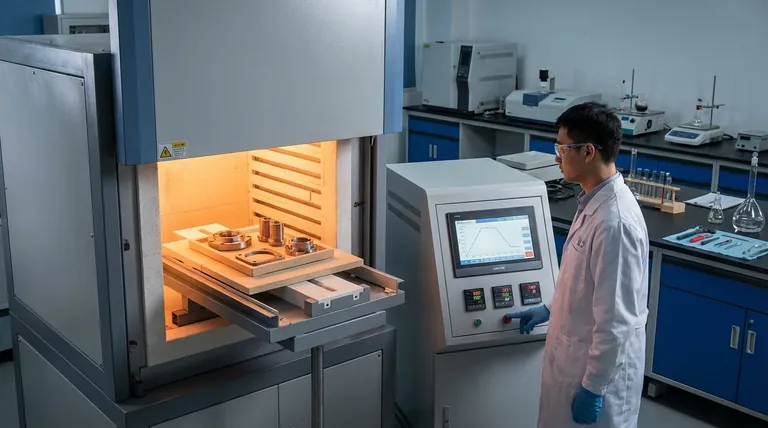In short, annealing fundamentally reduces a material's hardness. This is one of its primary industrial purposes, alongside increasing ductility and relieving internal stresses. The process achieves this by intentionally altering the material's internal microstructure through a controlled cycle of heating and, most importantly, slow cooling.
The core principle is that hardness comes from a disordered and stressed internal crystal structure. Annealing provides the thermal energy for the material's atoms to rearrange themselves into a more uniform, stress-free state, which is inherently softer and more ductile.

The Annealing Process: A Three-Stage Transformation
Annealing is not a single action but a carefully controlled three-part process. Each stage plays a critical role in resetting the material's internal structure.
Stage 1: Recovery (Heating)
The material is heated to a specific annealing temperature. This temperature is high enough to give the atoms mobility but typically remains below the material's melting point.
The initial input of thermal energy allows the material to relieve internal stresses locked into its crystal lattice, often from prior manufacturing steps like bending, rolling, or machining.
Stage 2: Recrystallization (Soaking)
The material is held at the annealing temperature for a set period. During this "soaking" phase, new, strain-free grains begin to form and grow.
Think of a work-hardened material as a pile of disorganized, misshapen bricks. Recrystallization is the process of breaking down that messy pile and forming new, perfectly uniform bricks.
Stage 3: Grain Growth (Slow Cooling)
This is the most critical stage for reducing hardness. The material is cooled at a very slow, controlled rate.
This slow cooling allows the newly formed crystal grains to grow in a large, uniform, and orderly manner, preventing new stresses from being locked in. Fast cooling (quenching) would do the opposite, trapping stress and creating a much harder, more brittle structure.
Why Annealing Reduces Hardness: A Microscopic View
The reduction in hardness is a direct result of changes happening at the atomic level within the material's grain structure.
Relieving Internal Stresses
When a metal is bent or hammered, its internal crystal structure becomes distorted and filled with defects called dislocations. These dislocations entangle and impede each other's movement, which is what we perceive as hardness.
Annealing provides the energy for atoms to move, allowing these dislocations to untangle and annihilate, effectively releasing the built-up internal stress.
Refining the Grain Structure
The recrystallization and slow cooling phases replace the small, distorted, and stressed grains of a hardened material with larger, more uniform, and stress-free grains.
In this new, orderly structure, the atomic planes can slide over one another more easily. This increased ability to deform under pressure is the very definition of ductility, which is the inverse of hardness.
Understanding the Trade-offs
While highly effective, annealing involves a clear set of engineering trade-offs that are critical to understand.
Hardness vs. Ductility
This is the primary trade-off. By annealing a material to make it softer and more ductile, you inherently reduce its tensile strength and resistance to wear. The material becomes easier to form but less capable of bearing high loads.
Time and Energy Costs
Annealing is an energy-intensive process. Heating large components in a furnace and allowing them to cool slowly over many hours consumes significant time and energy, adding to manufacturing costs.
Incompatibility with Hardening
Annealing is the functional opposite of hardening treatments like quenching. You cannot use annealing to make a material harder; its sole purpose in this context is to soften, improve ductility, or normalize a material's internal structure.
How to Apply This to Your Project
Choosing to anneal a material is driven by a specific engineering goal related to its workability or final properties.
- If your primary focus is improving machinability: Anneal the raw material before cutting, as the reduced hardness will lower tool wear and make cutting operations faster and cleaner.
- If your primary focus is preparing for extensive forming: Anneal the material to maximize its ductility, allowing it to be bent, stamped, or drawn into complex shapes without cracking.
- If your primary focus is reversing work hardening: Use annealing to soften a component that has become hard and brittle from a previous manufacturing step, preparing it for subsequent operations.
By understanding annealing, you gain precise control over a material's fundamental properties to meet your engineering demands.
Summary Table:
| Annealing Stage | Key Action | Effect on Hardness |
|---|---|---|
| Recovery | Heating to specific temperature | Relieves initial internal stresses |
| Recrystallization | Soaking at temperature | Forms new, strain-free grains |
| Grain Growth | Slow, controlled cooling | Creates large, uniform, soft structure |
Need precise control over your material's properties? At KINTEK, we specialize in lab equipment and consumables that enable exact thermal processing like annealing. Whether you're working on improving machinability, preparing materials for complex forming, or reversing work hardening, our solutions help you achieve the perfect balance between hardness and ductility. Contact our experts today to discuss how we can support your laboratory's material processing needs.
Visual Guide

Related Products
- Laboratory Muffle Oven Furnace Bottom Lifting Muffle Furnace
- 1800℃ Muffle Oven Furnace for Laboratory
- 1700℃ Muffle Oven Furnace for Laboratory
- High Temperature Muffle Oven Furnace for Laboratory Debinding and Pre Sintering
- 1400℃ Muffle Oven Furnace for Laboratory
People Also Ask
- What is the difference between a crucible and a furnace? Understanding the Heat Source and Container Partnership
- What is the temperature limit on a muffle furnace? A Guide to Selecting the Right Model
- What is the burnout cycle on a furnace? Stop This Destructive Overheating Pattern Now
- Does melting point ever change? Unlock the Secrets of Pressure and Purity
- What affects the melting point of a substance? Uncover the Key Factors & Forces



















